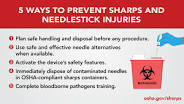Understanding the Dangers of Bloodborne Pathogens: Risks and Prevention Strategies

Understanding Bloodborne Pathogens: Risks and Prevention
Bloodborne pathogens are infectious microorganisms found in human blood that can cause disease in humans. The most common bloodborne pathogens include hepatitis B (HBV), hepatitis C (HCV), and human immunodeficiency virus (HIV).
Risks of Exposure
Healthcare workers, first responders, and individuals in certain industries are at a higher risk of exposure to bloodborne pathogens due to the nature of their work. Accidental needle sticks, cuts from sharp objects contaminated with infected blood, and exposure to mucous membranes are common ways these pathogens can be transmitted.
Prevention Measures
Preventing the transmission of bloodborne pathogens is crucial for maintaining a safe work environment. Some key prevention measures include:
- Using personal protective equipment (PPE) such as gloves, masks, and gowns
- Properly disposing of contaminated materials in designated biohazard containers
- Following standard precautions for handling blood and bodily fluids
- Getting vaccinated against hepatitis B
- Implementing engineering controls to minimize exposure risks
Training and Education
Employers should provide comprehensive training on bloodborne pathogens exposure control plans to employees who may be at risk. This training should cover proper procedures for handling potentially infectious materials, emergency response protocols, and ways to prevent exposure in the workplace.
In Conclusion
By understanding the risks associated with bloodborne pathogens and implementing effective prevention measures, individuals can significantly reduce the likelihood of exposure and protect themselves and others from potential infections. Stay informed, stay safe!
Understanding Bloodborne Pathogens: Key FAQs on Transmission, Risks, and Prevention
- What are bloodborne pathogens?
- How are bloodborne pathogens transmitted?
- What diseases can be caused by bloodborne pathogens?
- Who is at risk of exposure to bloodborne pathogens?
- How can the transmission of bloodborne pathogens be prevented?
What are bloodborne pathogens?
Bloodborne pathogens are infectious microorganisms that can be found in human blood and have the potential to cause diseases in humans. Common examples of bloodborne pathogens include hepatitis B (HBV), hepatitis C (HCV), and human immunodeficiency virus (HIV). These pathogens pose a significant risk to individuals who may come into contact with contaminated blood or bodily fluids, especially healthcare workers, first responders, and individuals in certain industries. Understanding what bloodborne pathogens are is crucial for implementing proper safety measures to prevent their transmission and protect against potential infections.
How are bloodborne pathogens transmitted?
Bloodborne pathogens are typically transmitted through contact with infected blood or other bodily fluids. Common modes of transmission include accidental needle sticks, cuts from sharp objects contaminated with infected blood, and exposure of mucous membranes to infected fluids. Healthcare workers, first responders, and individuals in certain industries are at a higher risk of exposure to bloodborne pathogens due to the nature of their work. It is crucial to follow proper safety protocols, use personal protective equipment, and practice good hygiene to prevent the spread of these infectious microorganisms.
What diseases can be caused by bloodborne pathogens?
Bloodborne pathogens can cause several serious diseases in humans. The most common ones include hepatitis B (HBV), hepatitis C (HCV), and human immunodeficiency virus (HIV). These diseases can have long-term health implications and may lead to chronic conditions if left untreated. It is crucial to understand the risks associated with bloodborne pathogens and take preventive measures to minimize the chances of exposure and transmission. Regular training, adherence to safety protocols, and proper use of personal protective equipment are essential in protecting individuals from these potentially harmful infections.
Who is at risk of exposure to bloodborne pathogens?
Individuals in certain occupations are at a higher risk of exposure to bloodborne pathogens. Healthcare workers, first responders, laboratory technicians, and individuals in the tattoo and piercing industry are among those most susceptible to potential exposure. Accidental needle sticks, contact with contaminated sharp objects, or exposure to infected blood and bodily fluids can put these individuals at risk. It is crucial for those in high-risk professions to follow strict safety protocols, use personal protective equipment, and undergo proper training to minimize the risk of transmission and ensure a safe working environment.
How can the transmission of bloodborne pathogens be prevented?
Preventing the transmission of bloodborne pathogens is essential to maintaining a safe and healthy environment. Employing proper infection control measures is key to reducing the risk of exposure. This includes using personal protective equipment such as gloves, masks, and gowns, ensuring the proper disposal of contaminated materials in designated biohazard containers, following standard precautions for handling blood and bodily fluids, getting vaccinated against hepatitis B, and implementing engineering controls to minimize exposure risks. Additionally, comprehensive training and education on bloodborne pathogens exposure control plans are crucial for individuals who may be at risk. By adhering to these preventive measures and staying informed about best practices, the transmission of bloodborne pathogens can be effectively minimized.




Leave a Comment